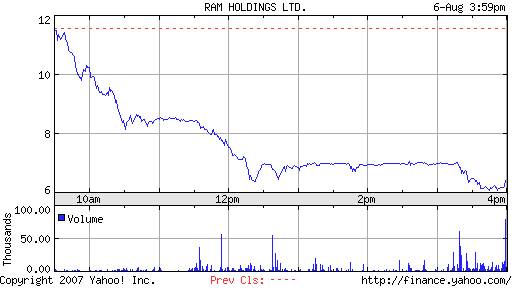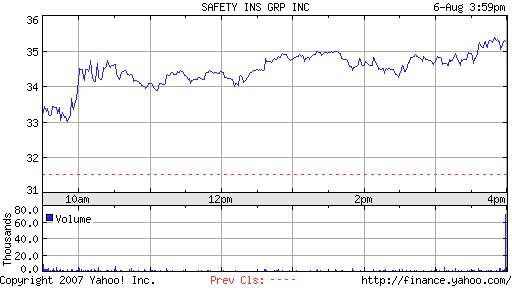When I do a review of links, I try not to do a linkfest, as much try to share my ideas, while annotating places where you can get more data.? I keep topical clipping folders.? Today’s review is on the Great Substitution of Equity for Debt, Formerly Led by Private Equity.? Usually I organize by subtopic when I write, but tonight I will do it by time, because it took me seven weeks to get back to this, and a lot has happened over those weeks.
Go back to mid-June.? 10-year Treasury rates were challenging 5.25%.? Rates all over the world had risen, and some predicted they would go higher, and choke off the private equity boom.? In hindsight, not a good argument, not because Treasury yields fell, but because junk credit spreads are more critical to private equity than treasury and high-grade yields.? In the short run, junk debt yields don’t react much to Treasury yields.? So most didn’t worry at the time.
Give Andy Kessler credit for timing. He expresses skepticism for private equity before Blackstone comes public, suggesting that all they do is borrow money against the assets of the target companies, and then foist them on the retail public later.? Well, that’s not all of what private equity does, but to a first approximation, that’s 90% of the deal.? He takes both sides of the issue, suggesting that conditions are stretched from a valuation standpoint, but suggesting that the insanity could go on for a while longer.
Failed deals often represent turning points, and by the end of June, both Thomson Learning and US Foodservice pulled their debt deals. The appetite for yield had diminished considerably, versus the need to protect capital.
In the short run though, the market is bouncy, and more deals piled up into early July, even as junk spreads began to widen.? I love the closing quote in this WSJ article: “It’s all worth keeping in mind as the market hits its rough spots. Roger Altman, chairman of Evercore Partners points out, for instance, that by any historical measure, the interest rates for junk bonds remain very cheap.? Barring a very steep climb in rates, Mr. Altman says, private equity ‘is a permanent feature of the capital markets. Nothing foreseeable can change that.'”? Mr. Altman is a bright man, no doubt, but turning points are only clear in hindsight.
Now, 2007 had already surpassed 2006 for private equity deals. Maybe completed deals are another issue.? Going to something more mundane, Mark Hulbert points out some research showing that companies that buyback their stock outperform the market.
By mid-July sentiment was definitely shifting in the debt markets, even as the equity markets rose.? More deals were having trouble getting done.? The willingness of lenders to take risk was declining, particularly on PIK bonds and Toggle notes.? Personally, I find it amazing that high yield investors buy instruments that may not pay interest in cash, given the dismal credit experience of such structures.? What would you expect from a company that doesn’t have enough money to make interest payments in cash?
The next article is a vision of the future. Five or so years from now, who will buy all of the new IPOs generated from today’s flood of private equity?? Then again, with the over-borrowing to make deals work, maybe not so many will come to market in the future, at least, not at the size that they left.
Take a look at the seven bad times to buy equities from John Hussman.? The last five of them came at times when the “Fed Model” would have told you to be in bonds.? The first two were close, but in the long haul, one was better off holding common stock through the declines.
By mid-July, we are a little past the recent peak, and buybacks are taking the place of LBOs in the market for shrinkage of the supply of equity.? With investment grade bond yields falling from mid-June, it seems like a reasonable thing to do.
I would never want to be a dedicated short investor.? Shorts are perpetually short the capital structure option, which the equity holders can exercise to lever up, when it is to their advantage to do so.? In this article, the difficulties of being short are explained, with the risks of private equity buyouts, and getting crowded out by naive shorts running 130/30 funds.? Jim Griffin at RealMoney takes an allied approach, suggesting that with equity getting replaced by debt, that equities are possibly a good deal here.
With rising junk spreads in the credit markets, by late July the buyer of choice for takeovers had become investment grade corporations because they could finance the purchase cheaply.? Private equity had gone quiet.? Things were bad enough, that investment banking bridge lenders wondered whether it wouldn’t be cheaper to drop out and pay the breakup fee on Texas Utilities rather than fund the deal personally.? The potential losses from many deals were mounting at the investment banks.? 46 deals had been pulled, versus zero in 2006.
So private equity is dead now, right?? I see it more as a sorting process.? Deals that make economic sense at higher lending rates will get done, and those that don’t make sense will be funded by the investment banks, or shelved for now, depending on the bridge lending deal terms.? It won’t be as big of a force in the market, but buybacks among investment grade corporations will continue to shrink the overall equity supply of the market for now.? I am still a moderate bull on the equity market.




 I know that Cramer and many others consider the news from the Bear Stearns call to be the financial equivalent of nuclear meltdown, but it’s not true: Exhibit 1 is the graphic above from The Wall Street Journal (
I know that Cramer and many others consider the news from the Bear Stearns call to be the financial equivalent of nuclear meltdown, but it’s not true: Exhibit 1 is the graphic above from The Wall Street Journal (